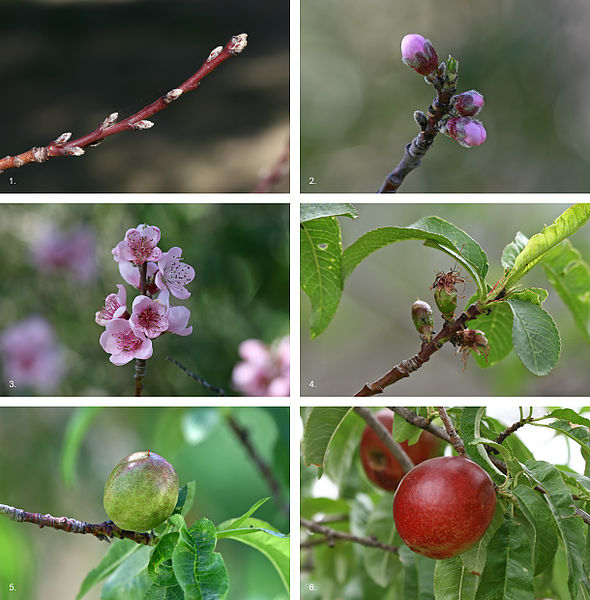
Size of this preview:
590 × 600 pixels. Other resolutions:
236 × 240 pixels |
472 × 480 pixels |
756 × 768 pixels |
1,007 × 1,024 pixels |
2,440 × 2,480 pixels.
Original file (2,440 × 2,480 pixels, file size: 919 KB, MIME type: image/jpeg)
|
| This is a featured picture, which means that members of the community have identified it as one of the finest images on the English Wikipedia, adding significantly to its accompanying article. If you have a different image of similar quality, be sure to upload it using the proper free license tag, add it to a relevant article, and nominate it. |
|
| This image was selected as picture of the day on the English Wikipedia for December 11, 2008. |
File history
Click on a date/time to view the file as it appeared at that time.
| Date/Time | Thumbnail | Dimensions | User | Comment | |
|---|---|---|---|---|---|
| current | 11:21, 6 June 2008 |
 | 2,440 × 2,480 (919 KB) | Jjron | {{Information |Description=Nectarine (''Prunus persica'') fruit development over a 7½ month period, from early winter to midsummer; East Gippsland, Victoria, Australia. #Bud formation can be observed on new growth on the plant (early winter) ([[:Image:0 |
| 11:14, 6 June 2008 |
 | 2,440 × 2,480 (919 KB) | Jjron | {{Information |Description=Nectarine (''Prunus persica'') fruit development over a 7½ month period, from early winter to midsummer; East Gippsland, Victoria, Australia. #Bud formation can be observed on new growth on the plant (early winter) ([[:Image:0 | |
| 13:00, 24 March 2008 |
 | 2,440 × 2,480 (993 KB) | Jjron | {{Information |Description=Nectarine fruit development over a 4½ month period, from early September 2007 to mid January 2008; East Gippsland, Victoria, Australia. #. Flower buds form and leaves start to develop.<br> #. Flowers fully develop and are poll |
File usage
The following pages on the English Wikipedia use this file (pages on other projects are not listed):
- Drupe
- Fruit
- Peach
- Prunus
- User:Abyssal/bla
- User:Haoreima/List of Meitei plant common names
- User:Jjron
- User:Jjron/Gallery/FPs
- User:Jjron/Gallery/Plants
- User talk:Jjron/Archive 3
- Wikipedia:Featured picture candidates/Image:Nectarine Fruit Development.jpg
- Wikipedia:Featured picture candidates/June-2008
- Wikipedia:Featured pictures/Plants/Fruits
- Wikipedia:Featured pictures thumbs/11
- Wikipedia:Picture of the day/December 2008
- Wikipedia:WikiProject Food and drink/Recognized content
- Wikipedia:WikiProject Food and drink/Showcase
- Wikipedia:WikiProject Food and drink/Showcase/FM
- Wikipedia:WikiProject Food and drink/Showcase/POTD
- Wikipedia:WikiProject Plants/Recognized content
- Wikipedia:Wikipedia Signpost/2008-06-23/Features and admins
- Wikipedia:Wikipedia Signpost/2008-06-23/SPV
- Wikipedia:Wikipedia Signpost/Single/2008-06-23
- Wikipedia talk:2008 main page redesign proposal/Archive 4
- Template:POTD/2008-12-11
- Portal:Plants/Recognized content
Global file usage
The following other wikis use this file:
- Usage on arc.wikipedia.org
- Usage on ar.wikipedia.org
- Usage on ast.wikipedia.org
- Usage on ast.wiktionary.org
- Usage on ba.wikipedia.org
- Usage on be-tarask.wikipedia.org
- Usage on bg.wikipedia.org
- Usage on bn.wikipedia.org
- Usage on bo.wikipedia.org
- Usage on bs.wikipedia.org
- Usage on crh.wikipedia.org
- Usage on cv.wikipedia.org
- Usage on diq.wikipedia.org
- Usage on dsb.wikipedia.org
- Usage on en.wikiversity.org
- Usage on eo.wikipedia.org
- Usage on es.wikipedia.org
- Usage on fa.wikipedia.org
- Usage on fr.wikipedia.org
- Usage on ga.wikipedia.org
- Usage on gl.wikipedia.org
- Usage on gl.wiktionary.org
- Usage on he.wikipedia.org
- Usage on hi.wikipedia.org
- Usage on hsb.wikipedia.org
- Usage on hu.wikipedia.org
- Usage on hy.wikipedia.org
- Usage on id.wikipedia.org
- Usage on it.wikipedia.org
- Usage on kk.wikipedia.org
- Usage on kn.wikipedia.org
- Usage on koi.wikipedia.org
- Usage on ko.wikipedia.org
View more global usage of this file.

